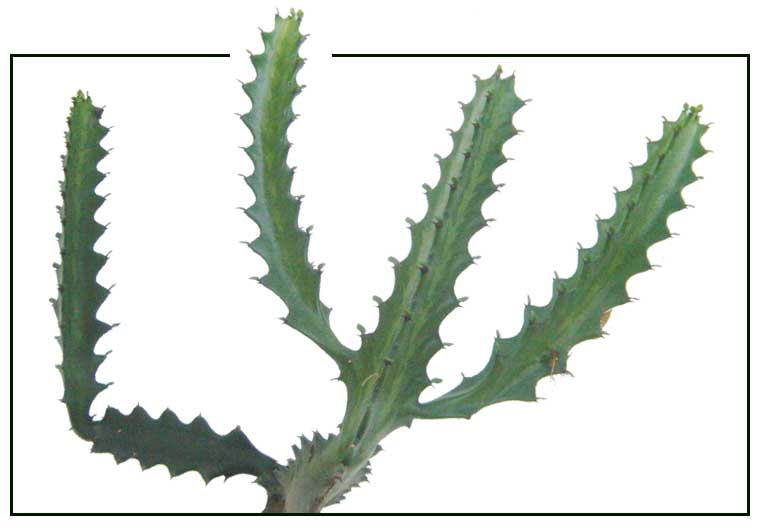| General
info
· There are more than 2,000 species of Euphorbia
worldwide. A significant number are succulent, all contain latex and
have a unique flower structure. Although it is present in many traditional
medicinal systems, nearly all possess poison or toxicity.
Botany
Euphorbia antiquorum is a succulent woody shrub growing 1 to 3 meters high with
milky sap. Mature stem is cylindrical in shape with 3 to 6 ridges; younger
branches green with 3 to 5 ridges; the projection of the ridges are armed
with a pair of 2- to 3-millimeter long spines. Leaves are few, borne on the ridges, succulent, obovate to oblanceolate
to spathulate in shape. Apex is obtuse with a small pointed projection,
base gradually narrowing downward, sessile. Male flower possess only 1 stamen, filament short; female
flower situated alone at the center of the cyathium, protruding beyond
the involucre. Styles are 3, not joined to each other, each style forking
towards the tip. Inflorescence is yellowish-green, monoecious, composed
of several staminate (male) flowers and one pistillate (female) flower
borne on a green, hemispherical involucre. Whole cuplike cymose
inflorescence is called cyathium. Fruits are glabrous, smooth, about 1 centimeter in diameter.
Distribution
- Widely cultivated throughout
the Philippines as an ornamental but may occasionally be found
as an escape from cultivation.
Constituents
- From the latex, study isolated three new triterpenes, euphol-3-O-cinnamate, antiquol A and antiquol B, with known triterpenes, euphol, 24-methylenecycloartanol and cycloeucalenol; together with a nonacosene, sitosterol and p-acetoxyphnol.
- Study isolated ten compounds viz.
glutinol (1), taraxerol (2), friedelanol (3), stigmasterol (4), 23-cycloarten-3β,25-diol (5), ent-13S-Hydroxy-16-atisene-3,14-dione (6), 6,7,8-trimethoxylcoumarin (7), 3,3′,4′-tri-O-methylellagic acid (8), ent-kaurane-3-oxo-16β,17-diol (9) and daucosterol (10). (15)
Properties
· Bitter tasting, cooling effect.
· Stomachic, antifebrile, antiphlogistic, anti-infectious, antidermatosis.
· Studies have shown hepatoprotective, antioxidant, insecticidal, antibacterial, antifungal, analgesic, anti-inflammatory, mosquitocidal, anti-hyperglycemic, anticancer properties.
Parts
utilized
· Stem, latex.
· Collected the whole year round.
· Remove cortex after harvest, cut into sections, roast
in frying pan till brownish-yellow.
Uses
Folkloric
· Acute gastroenteritis: use 3 to 6 gms dried materials in decoction.
· Malignant furuncle and carbuncle infections: use pounded fresh
stem (quantity sufficient) and apply as poultice.
· Scabies, various dermatoses: apply sap over afflicted areas.
· In India, Juice of plant used for chest pains and constipation. Latex applied to boils for early suppuration and healing. Bark is used as purgative. Latex used for killing wound maggots. Saline extract used as antibiotic.
· In Andhra Pradesh, India, latex from stem applied on spots of burn injury. Stem is heated on fire, and juice expressed is topically applied on wounds to facilitate healing. (22)
Livestock
• Milk of E. antiquorum is applied near to eyes for cattle to
treat conjunctivitis and corneal opacities.
• Milk is applied to the neck and joints of cattle to treat black
quarter.
Others
• Ritual / Superstition: In Northeast India, one of the Euphorbia species used to ward off evil spirits.
Caution
!
• This drug is toxic. Frying neutralizes
the toxin, after which it can be taken orally. However, excessive dosage
may still cause diarrhea.
• The milky sap or latex, which is also poisonous, must not come
in contact with the eyes; skin contact with this sap may cause skin
inflammation. Take caution too that this is not administered to pregnant
patients.
Studies
• Anti-Epstein
Barr Virus Activation: Study yielded three triterpene
alcohols from the latex. Some compounds showed potent inhibitory effects
on Epstein-Barr virus early antigen activation. (3)
• Hepatoprotective
/ Antioxidant: Study of aqueous extract of the aerial
parts of Euphorbia antiquorum showed significant antioxidant activity
and also significant dose-dependent hepatoprotection, effects comparable
to Silymarin and Sodium metabisulphite. The results helps justify its
traditional use for treating jaundice. (4)
• Insecticidal:
Study of the insecticidal properties of EA showed the
components were best extracted by xylene. The xylene-latex extract was
highly toxic to soft bodied insects / spiders. On storage, both the xylene-latex extract and the n-hexane fraction were still highly stable with only a 3 % decline of activity after one year. (5)
• Flavonoids / Antibacterial / Latex: Study evaluated the latex and flavonoids from roots of Euphorbia antiquorum for antibacterial activity against Pseudomonas aeruginosa, Klebsiella pneumonia, Proteus vulgaris, Escherichia coli, Streptococcus anginosus and Bacillus subtilis. Results showed the flavonoids from E. antiquorum latex were effective against gram positive and gram negative bacterial species, with 30 µg/ml extract concentration sufficient to constrain bacterial growth. The pure latex of E. antiquorum yielded 7.54 mg/g total flavonoid. (9)
• Anti-Hyperglycemic / Roots: Study evaluated the anti-hyperglycemic effect of E. antiquorum root in streptozotocin-nicotinamide-induced type 2 diabetes mellitus and fructose induced insulin resistance models. Treatment with alcohol and aqueous extracts of EA roots resulted in significant (p<0.001) lowering of serum blood glucose and GHb levels in both models. (10)
• Mosquitocidal / Aedes aegypti / Latex: Ae. aegypti is the primary vector of chikungunya, yellow fever, and dengue. A methanolic latex extract f E. antiquorum tested for larvicidal activity against 4th instar larvae of Ae. aegypti showed high toxicity to the mosquito larvae with LC50 of 10.70 ml/dl at 48 hr. exposure. (11)
• Analgesic / Anti-Inflammatory: Study evaluated aqueous ethanolic extract of whole plant for analgesic activity (hot plate, acetic acid induced writhing and formalin induced writhing methods) in Swiss albino mice and anti-inflammatory effect (carrageenan induced rat paw edema method) in Long Evans rats. Results showed significant dose dependent analgesic effect (p<0.01) and significant anti-inflammatory (p<0.001) effect. Chemical constituents tannins, flavanoids, terpenoids, and alkaloids may be responsible for the observed analgesic and anti-inflammatory effects. (12)
• Silver Nanoparticles / Latex / Antibacterial, Larvicidal and Anticancer: Study reports on the rapid biosynthesis of silver nanoparticles (EAAgNPs) using aqueous latex extract of E. antiquorum as potential bioreductant. Phyto-fabricated EAAgNOs exhibited significant antimicrobial and larvicidal activity against bacterial human pathogens as well as Cx quinquefasciatus and Ae. aegypti. In vitro cytotoxicity assessment showed potential anticancer activity against human cervical carcinoma cells (HeLa). The EAAgNPs can be considered environmentally benign and non-toxic nanobiomaterial for medical applications. (13)
• Aldose Reductase Inhibitory Effect / Terpenoids / Antidiabetic: Study evaluated the ethanol, petroleum ether, and aqueous extracts of E. antiquorum for anti-hyperglycemic and aldose inhibitory effect in Alloxan-induced diabetic rats. All extracts demonstrated hypoglycemic effect, but the ethanol extract (69%) showed more effect which was comparable to standard drug Glibenclamide. Results showed EA has antidiabetic and aldose reductase inhibitory effect. Molecular docking study showed Antiquol A to be one of the best aldose reductase inhibitor. (14)
• Anticancer / Human Cervical Cancer Cells Via Apoptotic Pathways / Latex: The latex of EA has shown inhibitory effects on several cancer cell lines. Study supported the hypothesis that Euphorbia antiquorum causes cell death via apoptotic pathways in human cervical adenocarcinoma HeLa cells. (16)
• Invention / Anticancer Herbal Extract: Invention claims an herbal extract from E. antiquorum to inhibit tumor growth of hepatoma cells, colorectal adenocarcinoma cells, monocyte-like lymphoma and leukemia cells. (17)
• Antifungal / Latex: Study evaluated the antifungal effect of methanolic latex extract on some human pathogenic fungi viz., Candida albicans, C. cruzi, C. tropicalis, C. parapolisis, and Aspergillus sps. The latex showed significant zone of inhibition in a dose dependent manner. (18)
• Anticancer / S-Phase Arrest in Human Cervical Cancer Cells / Latex: Study evaluated the influence of EA in human cervical cancer cells. Study showed EA could downregulate topoisomerase, and activate ATM kinase, which then induce parallel Chk 1/2 and MAPK signaling pathways to promote degradation of Cdc25A to induce S-phase arrest in human cervical cancer HeLa cells. (19)
• Adsorption / Activated Carbon for Dye Removal: Study reports on the use of E. antiquorum wood for the convenient and economically preparation of activated carbon with high absorptive capacity. The adsorbent was used for the adsorptive removal of four categories of dyes. (20) Study evaluated the mechanism of adsorption of Basic Red 29 from aqueous solutions using activated carbon prepared from E. antiquorum wood. (21)
Availability
Wild-crafted.
|





